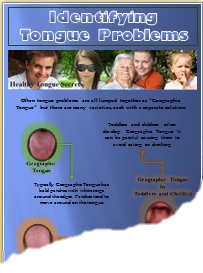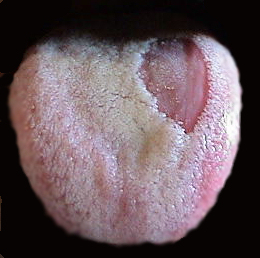Yes, Tim! I want to Learn the 10 Secrets to a Healthy Tongue!
Send me my FREE eSeries today!
Thrush Tongue
By Tim McMahon
Thrush is a condition of the tongue that is quite common in babies but often affects adults as well. Thrush is simply an overgrowth of “Candida Albicans” which looks like white fur. Candida is a strain of yeast that thrives in dark moist places, especially in warm human bodies, although it can be found in everything from birds to horses. In the tongue to the right it is easy to see the thrush coating primarily because there is a patch where the thrush has actually peeled off leaving a bare patch of raw tongue underneath.
This does not indicate that the patient is getting better but probably that the thrush had simply gotten so long that the tongue shed its coating of papillae to get get rid of it. To verify that the white coating is actually Yeast the doctor will simply scrape it a bit and run a simple test to confirm the diagnosis of oral thrush.
Yeast is a controversial topic with two extreme positions, many people say it is the cause of almost all major illnesses… while many in the medical establishment say that it is prevalent in everyone and relatively harmless unless your immune system is compromised. The truth (as in most things) is probably somewhere in between.
Yeast is a form of fungus, education and research scientists have described over 1500 species of yeast and it is estimated that these only represent 1% of the total forms of yeast. With so many different species of yeast it is no wonder it is so difficult to determine how to treat it. Some like bread yeast and brewers yeast are beneficial while others like Candida albicans leads to opportunistic oral and genital infections in people. There are also lesser known strains of yeast like Candida glabrata, Candida tropicalis, Candida stellatoidea, Candida krusei, Candida parapsilosis, Candida guilliermondii, Candida viswanathii, Candida lusitaniae and Rhodotorula mucilaginosa. There is some debate as to whether systemic fungal infections weaken your entire system or simply take advantage of an immune systems that has already been compromised like in the case of AIDS.
One thing is certain and that is once Yeast takes hold it is difficult to eradicate especially with home remedies. When yeast is prevalent enough to cover the entire tongue as in the thrush picture it is already a systemic problem. Even if you could scrape it off the entire tongue it would grow back in short order. (and it would be a painful scraping process).
Yeast is considered “commensal” meaning that it survives without harming the host. But it has a darker side because it is really just waiting for an opportunity to strike. Thus it may be called “opportunistic”. If it is allowed to grow unchecked by the “good” bacteria in our system, it develops “roots” that penetrate the mucus membrane and it mutates into a pathogenic killer.
There are many ways that yeast can find this opportunity but the most common is if you take antibiotics (and who doesn’t?). Your system is already weak (that’s why you are taking the antibiotics) and eventually that pathogen is killed by the antibiotics but the benficial bacteria are also killed along with the harmful bacteria. Unfortunately, yeast can form spores where they can survive most anything (including antibiotics). Then the harmful yeasts such as Candida Albicans come out of their spores and cause a variety of different diseases and conditions before the helpful bacteria can return. Research suggests that the beneficial microorganisms in your gut perform a host of useful functions, in addition to preventing growth of harmful, pathogenic bacteria, such as producing vitamins K and biotin, training the immune system, and producing certain hormones.
When the yeast begins to grow unchecked it is called Candidiasis. In my younger years I had a severe case of Crohn’s disease combined with Candidiasis. At
this time I developed white patches on my tongue that seemed to migrate around. I later discovered that it was a combination of thrush (yeast) and geographic tongue.
During the treatment process for the Crohn’s disease I found that antibiotics killed the thrush (temporarily) but once I stopped taking them the thrush would come back worse than ever!” (Thrush by the way is simply “Candida Albicans” or a form of Yeast that is specifically growing on the tongue.)
As the thrush got worse, my overall system got weaker and I was less able to deal with outside stresses so I developed food allergies, fatigue, mold allergies…
The white tongue of thrush is just a visible sign that Candida is all over your body, it is taking over your digestive system, poisoning your blood and overall weakening your system. In the case of Candidiasis topical treatments will only work temporarily… the key is to treat it systemically.
Diflucan is often prescribed but it is generally only given long enough to knock the Candida down and before long it is back. Nystatin liquid is also prescribed but once again not for a long enough period of time to really kill all the Candida (remember they’ve got those spores so thrush can come back).
The key to my being able to eliminate Crohn’s Disease was that,
1) I first got rid of the systemic yeast
2) I killed the bad bacteria and protozoa with Flagyl
3) I aggressively worked to restore the good bacteria while I still had a “clean slate” so to speak.
The important thing to remember is that Yeast is very closely related to a variety of tongue problems and can weaken your entire system. Eliminating it is not easy. (I was lucky I found a doctor that specialized in Yeast and he was only a 2 1/2 hour drive from my home.) And he used the commonly prescribed drug “Nystatin” in an entirely different way. The regular way is to swish the liquid around in you mouth for a few seconds and then swallow. This is almost useless. Diflucan is good but you can’t take it long enough to kill off all the yeast. You need something you can safely take for an extended period of time (while at the same time taking probiotics to build up the good bacteria).
(If you are interested I’ll give you the full details on how to treat thrush and restore the good bacteria in my book “Healthy Tongue Secrets”). In addition to the chapter on Thrush in the book I have also included a special bonus on Yeast and the treatment I used to restore my system to health.
Click Here for More Information on “Treating an Beating Geographic Tongue and Other Tongue Problems“
Is There a Cure for Geographic Tongue?
About the Author Tim McMahon
My name is Tim McMahon and I’ve been there! I suffered from Geographic Tongue and through a strange set of circumstances I learned how to get rid of it. You see, shortly after college I fought the battle of my life (literally). Somehow, I developed Crohn’s disease and went from a healthy 135 lbs down to 95 lbs and literally thought I was going to die (and I looked like it too.) In the process, I had a huge chunk of my intestines removed. From that I developed Geographic Tongue and eventually that led to my discovering the solution. You can follow this link, if you’d like to hear My Whole Story

Download Tongue Problems Infographic
Often tongue problems are all lumped together as “Geographic Tongue” but there are many varieties, each with a separate solution. Our Tongue Problems Infographic displays pictures and descriptions of the most common tongue problems. To receive your copy, just enter your email address below.

